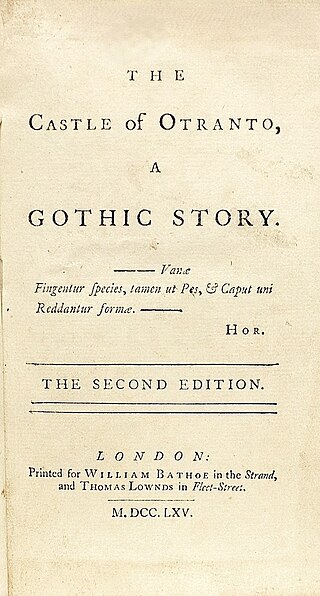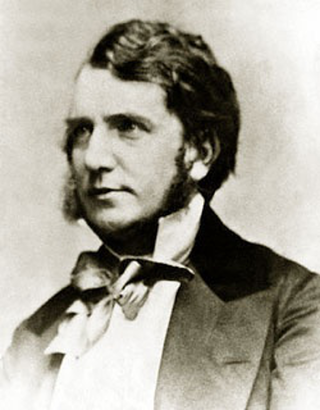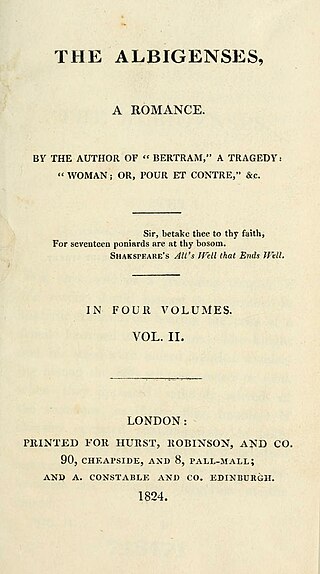
Gothic fiction, sometimes called Gothic horror, is a loose literary aesthetic of fear and haunting. The name refers to Gothic architecture of the European Middle Ages, which was characteristic of the settings of early Gothic novels.

Joseph Thomas Sheridan Le Fanu was an Irish writer of Gothic tales, mystery novels, and horror fiction. He was a leading ghost story writer of his time, central to the development of the genre in the Victorian era. M. R. James described Le Fanu as "absolutely in the first rank as a writer of ghost stories". Three of his best-known works are the locked-room mystery Uncle Silas, the lesbian vampire novella Carmilla, and the historical novel The House by the Churchyard.

Ann Radcliffe was an English novelist and a pioneer of Gothic fiction. Her technique of explaining apparently supernatural elements in her novels has been credited with gaining respectability for Gothic fiction in the 1790s. Radcliffe was the most popular writer of her day and almost universally admired; contemporary critics called her the mighty enchantress and the Shakespeare of romance-writers, and her popularity continued through the 19th century. Interest in Radcliffe and her work has revived in the early 21st century, with the publication of three biographies.
Patrick O'Brian, born Richard Patrick Russ, was an English novelist and translator, best known for his Aubrey–Maturin series of sea novels set in the Royal Navy during the Napoleonic Wars, and centred on the friendship of the English naval captain Jack Aubrey and the Irish–Catalan physician Stephen Maturin. The 20-novel series, the first of which is Master and Commander, is known for its well-researched and highly detailed portrayal of early 19th-century life, as well as its authentic and evocative language. A partially finished 21st novel in the series was published posthumously containing facing pages of handwriting and typescript.

Master and Commander is a nautical historical novel by the English author Patrick O'Brian, first published in 1969 in the US and 1970 in the UK. The book proved to be the start of the 20-novel Aubrey–Maturin series, set largely in the era of the Napoleonic Wars, on which O'Brian continued working until his death in 2000.

The first Irish prose fiction, in the form of legendary stories, appeared in the Irish language as early as the seventh century, along with chronicles and lives of saints in Irish and Latin. Such fiction was an adaptation and elaboration of earlier oral material and was the work of a learned class who had acquired literacy with the coming of Latin Christianity. A number of these stories were still available in manuscripts of the late medieval period and even as late as the nineteenth century, though poetry was by that time the main literary vehicle of the Irish language.
The Aubrey–Maturin series is a sequence of nautical historical novels—20 completed and one unfinished—by English author Patrick O'Brian, set during the Napoleonic Wars and centring on the friendship between Captain Jack Aubrey of the Royal Navy and his ship's surgeon Stephen Maturin, a physician, natural philosopher, and intelligence agent. The first novel, Master and Commander, was published in 1969 and the last finished novel in 1999. The 21st novel of the series, left unfinished at O'Brian's death in 2000, appeared in print in late 2004. The series received considerable international acclaim, and most of the novels reached The New York Times Best Seller list. These novels comprise the heart of the canon of an author often compared to Jane Austen, C. S. Forester and other British authors central to English literature.

Charles Robert Maturin, also known as C. R. Maturin, was an Irish Protestant clergyman and a writer of Gothic plays and novels. His best known work is the novel Melmoth the Wanderer, published in 1820.

Melmoth the Wanderer is an 1820 Gothic novel by Irish playwright, novelist and clergyman Charles Maturin. The novel's titular character is a scholar who sold his soul to the devil in exchange for 150 extra years of life, and searches the world for someone who will take over the pact for him, in a manner reminiscent of the Wandering Jew.

Fantasy literature is literature set in an imaginary universe, often but not always without any locations, events, or people from the real world. Magic, the supernatural and magical creatures are common in many of these imaginary worlds. Fantasy literature may be directed at both children and adults.
Edith Birkhead (1889-1951) was a lecturer in English Literature at the University of Bristol and a Noble Fellow at the University of Liverpool. She wrote a pioneering work on Gothic literature: The Tale of Terror (1921). This work described the fascination with supernatural fiction in English literature from the publication of Horace Walpole's The Castle of Otranto in 1764 to Charles Maturin's Melmoth the Wanderer in 1820 on to modern times. She included works from Europe as well as America, including Nathaniel Hawthorne and Edgar Allan Poe.
The sentimental novel or the novel of sensibility is an 18th- and 19th-century literary genre which celebrates the emotional and intellectual concepts of sentiment, sentimentalism, and sensibility. Sentimentalism, which is to be distinguished from sensibility, was a fashion in both poetry and prose fiction beginning in the eighteenth century in reaction to the rationalism of the Augustan Age.
Catharine Selden was an Irish writer of Gothic novels in the early 19th century.
Events from the year 1825 in Ireland.

Leixlip is a town in north-east County Kildare, Ireland. Its location on the confluence of the River Liffey and the Rye Water has marked it as a frontier town historically: on the border between the ancient kingdoms of Leinster and Brega, as an outpost of The Pale, and on Kildare's border with County Dublin. Leixlip was also a civil parish in the ancient barony of Salt North.
Henrietta Mosse or Henrietta Rouviere was a British romantic novelist who was born in Ireland.
Irish Gothic literature developed in the eighteenth and nineteenth centuries. Most of the writers were Anglo-Irish. The period from 1691 to 1800 was marked by the dominance of the Protestant Ascendancy, Anglo-Irish families of the Church of Ireland who controlled most of the land. The Irish Parliament, which was almost exclusively Protestant in composition, passed the Penal Laws, effectively disenfranchising the Catholic majority both politically and economically. This began to change with the Acts of Union 1800 and the concomitant abolition of the Irish Parliament. Following a vigorous campaign led by Irish lawyer Daniel O'Connell, Westminster passed the Roman Catholic Relief Act 1829 removing most of the disabilities imposed upon Catholics.

Romance, is a "a fictitious narrative in prose or verse; the interest of which turns upon marvellous and uncommon incidents". This genre contrasted with the main tradition of the novel, which realistically depict life. These works frequently, but not exclusively, take the form of the historical novel. Walter Scott describes romance as a "kindred term", and many European languages do not distinguish between romance and novel: "a novel is le roman, der Roman, il romanzo".
The eighteenth-century Gothic novel is a genre of Gothic fiction published between 1764 and roughly 1820, which had the greatest period of popularity in the 1790s. These works originated the term "Gothic" to refer to stories which evoked the sentimental and supernatural qualities of medieval romance with the new genre of the novel. After 1820, the eighteenth-century Gothic novel receded in popularity, largely overtaken by the related genre of historical fiction as pioneered by Walter Scott. The eighteenth-century Gothic was also followed by new genres of Gothic fiction like the Victorian penny dreadful.

The Albigenses is an 1824 gothic historical novel by the Irish writer Charles Maturin, published in four volumes by Hurst, Robinson, and Company in London and Constable in Edinburgh. It was published in the year of his death, and was his final novel followed by the short story Leixlip Castle (1825). The plot is set in the early thirteenth century based on the Catharists of Southern France, also known as Albigenses, after the town of Albi. Maturin, a Church of Ireland clergyman, was known for his Gothic novels and plays. Inspired by the success of Walter Scott's Waverley novels, he turned to historical fiction and the novel bears particular similarities with Scott's Ivanhoe.











